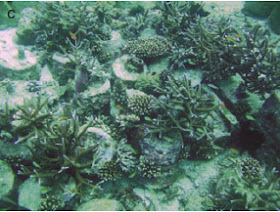Coral reefs are important marine ecosystems and vital economic resources to coastal communities across the tropics. However Corals in almost all areas have been dying back, due to pollution, rising sea temperatures, increased tropical cyclones and invasive species, such as the Crown of Thorns Starfish. This has led to a number of attempts to recreate reefs in areas where they have died back, however most of these have been expensive and have failed to involve and gain the support of local people, due to a reliance on imported technology and expertise, and most have not succeeded in the long term, either due to a failure to address the problems that caused the original reef die-back, or due to larger-scale climatic or environmental problems that were hard to predict.
In a paper published in the journal Oryx on 4 October 2012, a team of scientists led by Nur Fadli of the Centre for Marine and Fisheries Studies at Syiah Kuala University describe the results of an attempt to artificially re-create a Coral Reef by local communities on Pulau Weh, an island off the northern tip of Sumatra in Indonesia.
The location of the artificial reef on Pulau Weh. Fadli et al. (2012).
The project was run by local resident Pak Dodent and members of staff of Rubiah Tirta Divers, using grants from funds to help rebuild local communities after the 2004 tsunami, which had devastated the original reef. The artificial reef comprised 2690 concrete modules, each 1.25 m², each made up of nine round blocks with sloping sides and a section of plastic piping at the top. These were surrounded by four oblong blocks, also with sloping sides, and each with four sections of plastic tubing on top. Each of these modules took 40 person/hours to install, at a total cost of IDR 440 000 (US$45). The project provided three months employment for three people.
Diagram of a single reef module. Fadli et al. (2012).
Fragments of Coral were attached to the upright pipes, and the blocks were scrubbed to prevent competition from other organisms. Periodic maintenance was also carried out, righting overturned blocks, re-attaching or replacing Coral fragments that had become detached etc.
Individual block with attached Coral. Fadli et al. (2012).
Average Coral cover on the artificial reef blocks was 24% in the first year, rising to 64% in the third year. The modules were quickly colonized by additional species of Coral, including some classed as Near Threatened and Vulnerable on the IUCN Red List. The artificial reefs also succeeded in attracting Fish, with 29 species recorded across 250 m² of artificial reef, including some pelagic predators.
In addition the project was successful in attracting tourists, both local and international, and received considerable support from the local community, suggesting that it was perceived as beneficial.
Top, a new reef module. Middle, a three-year-old module with a diverse range of corals. Bottom, reef fish around an artificial reef module. Fadli et al. (2012).
Unfortunately in the third year of the project the area suffered a sharp rise in sea temperatures, leading to a Coral bleaching event (an event in which the Corals respond to environmental stress by rejecting their symbiotic algae), which killed almost all of the Corals on both the artificial reefs and nearby natural reefs.
However the project did demonstrate that community-lead reef restoration schemes such as this have genuine potential. The 2004 tsunami lead to a large amount of funds becoming available in the region for community projects, but did not damage reefs in many places, so this project was fairly unique. Fadli et al. note that in excess of US$200 million has been spent on various artificial reef projects around the world, which has resulted in less than 1 km² of new reef being created. The Pulau Weh project cost a total of US$8500, and created 325 m² of new reef, whilst creating jobs for local people, and without the need for expensive outside technology or expertise. This suggests that similar projects have the potential to be more successful than traditional approaches to reef rebuilding, and that such projects should form a key part of future reef management and restoration.






